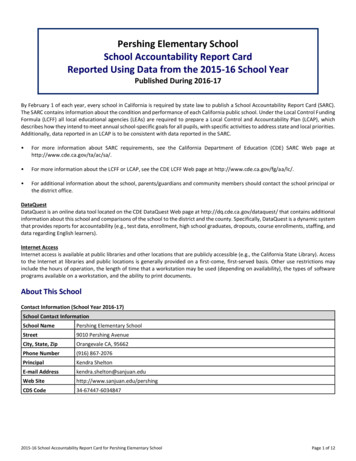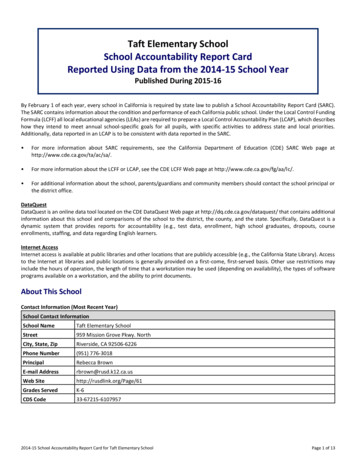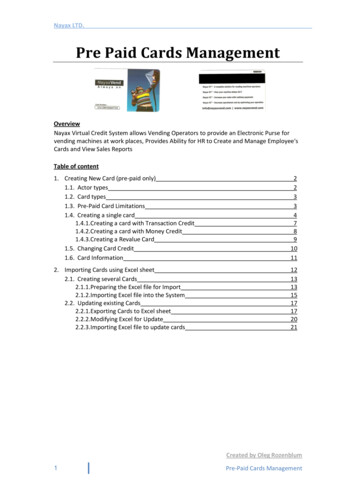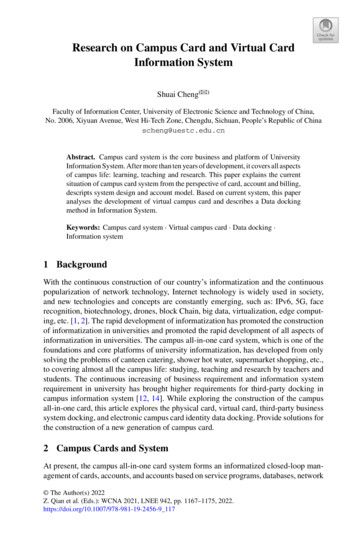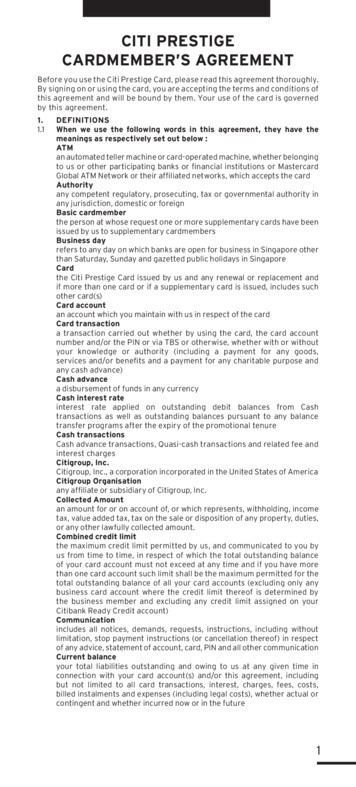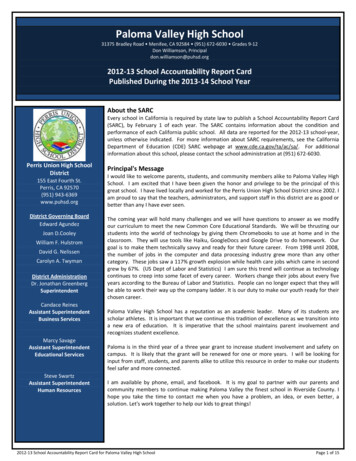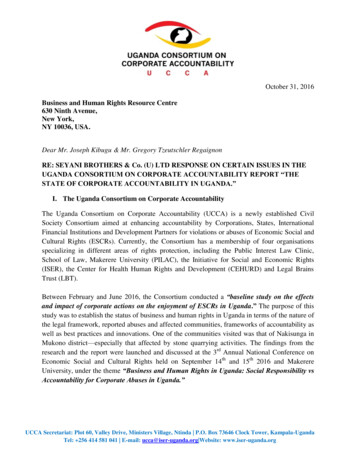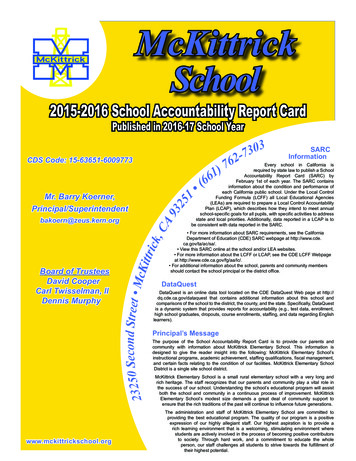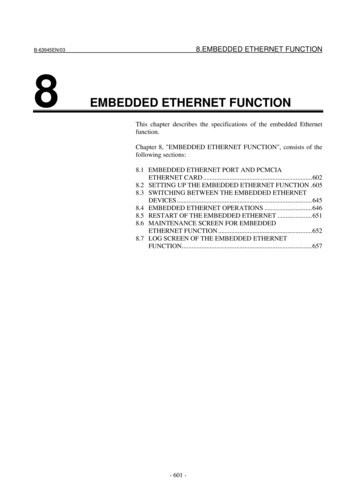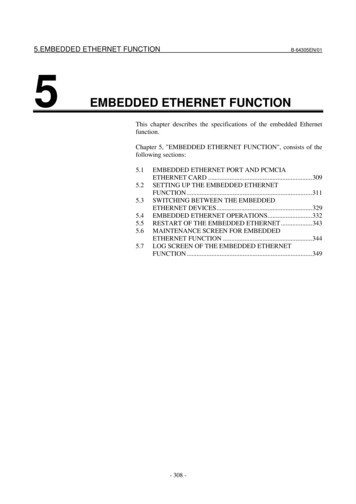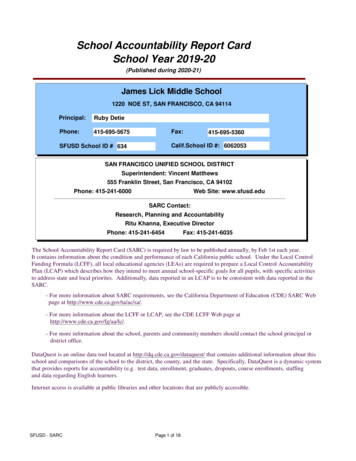
Transcription
School Accountability Report CardSchool Year 2019-20(Published during 2020-21)James Lick Middle School1220 NOE ST, SAN FRANCISCO, CA 94114Principal:Ruby l ID #: 6062053SFUSD School ID # 634SAN FRANCISCO UNIFIED SCHOOL DISTRICTSuperintendent: Vincent Matthews555 Franklin Street, San Francisco, CA 94102Phone: 415-241-6000Web Site: www.sfusd.eduSARC Contact:Research, Planning and AccountabilityRitu Khanna, Executive DirectorPhone: 415-241-6454Fax: 415-241-6035The School Accountability Report Card (SARC) is required by law to be published annually, by Feb 1st each year.It contains information about the condition and performance of each California public school. Under the Local ControlFunding Formula (LCFF), all local educational agencies (LEAs) are required to prepare a Local Control AccountabilityPlan (LCAP) which describes how they intend to meet annual school-specific goals for all pupils, with specific activitiesto address state and local priorites. Additionally, data reported in an LCAP is to be consistent with data reported in theSARC.- For more information about SARC requirements, see the California Department of Education (CDE) SARC Webpage at http://www.cde.ca.gov/ta/ac/sa/.- For more information about the LCFF or LCAP, see the CDE LCFF Web page athttp://www.cde.ca.gov/fg/aa/lc/.- For more information about the school, parents and community members should contact the school principal ordistrict office.DataQuest is an online data tool located at http://dq.cde.ca.gov/dataquest/ that contains additional information about thisschool and comparisons of the school to the district, the county, and the state. Specifically, DataQuest is a dynamic systemthat provides reports for accountability (e.g. test data, enrollment, graduates, dropouts, course enrollments, staffingand data regarding English learners.Internet access is available at public libraries and other locations that are publicly accessible.SFUSD - SARCPage 1 of 18
About This SchoolSchool Description and Mission StatementThis section provides information about the school's goals and programs.James Lick Middle School is nestled in the heart of Noe Valley, a beautful neighborhood in SanFrancisco. We are a mid-sized school, serving over 600 students and families. One of our biggestassets is our diverse student population, including about 65% Latino, 15% African-American, and12% White. Over the past five years, we have made great gains in terms of student achievementwhich include about a 160 point gain in state-wide test scores. We attribute these gains largely to theinvolvement of families and the highly collaborative work of a very dedicated staff.At our school, we believe in supporting students’ positive development in a variety of ways:socially/emotionally, academically, artistically, and physically. To support students’ social/emotionaldevelopment, we offer a range of counseling and support group opportunities through our counselingoffice. Students’ academic progress is ensured by a rigorous curriculum planned collaboratively byteams of teachers. We foster students’ development of their artistic talents by offering acomprehensive arts program. Lastly, our physcial education and sports programs provide students theopportunity to maintain a fit and healthy life style.Last year we adopted a school-wide mission statement in which we also articulated the commitment tosupport students’ development of leadership skills so that they can make a positive impact on theirlocal and global communities. At each grade level, we have projects where students haveopportunities to make a positive impact. We also offer leadership opportunites through programs suchas Student Council, Youth Outreach Workers, Safe School Ambassadors, Peer Resources (includingpeer education and peer mediation) and the James Lick Garden.We developed the following mission statement:Our mission at James Lick Middle School is to support and nurture our students, encouragingthem to challenge and overcome institutional limitations, realize their own potential, and achievehigh expectations. Our students will be informed, active participants and conscientious leaders withintheir local and global communities.Student Enrollment By Grade Level (School Year 2019-20)This table displays the number of students enrolled in each grade level at the school.Grade LevelK12345678Ungraded ElemEnrollment000000Grade Level9101112Ungraded SecTotal Enrollment1131741760Student Enrollment By Group (School Year 2019-20)SFUSD - SARCPage 2 of 18Enrollment00000463
This table displays the percent of students enrolled at the school who are identified as being in aparticular group.GroupAfrican AmericanAmerican Indian or Alaska NativeAsianFilipinoHispanic or LatinoPacific IslanderWhite (Not Hispanic)Two or More RacesSocioeconomically DisadvantagedEnglish LearnersStudents with DisabilitiesFoster YouthHomelessPercent of 9.7Section A (Conditions of Learning) begins on next page.SFUSD - SARCPage 3 of 18
A. Conditions of LearningState Priority: BasicThe SARC provides the following information relevant to the Basic State Priority (Priority 1):- Degree to which teachers are appropriately assigned and fully credentialed in the subject area and for thepupils they are teaching;- Pupils have access to standards-aligned instructional materials; and- School facilities are maintained in good repair.Teacher CredentialsThis table displays the number of teachers assigned to the school with a full credential, without a full credential,and those teaching outside of their subject area of competence. Detailed information about teacher qualificationscan be found at the CDE Web site at http://dq.cde.ca.gov/dataquest/.TeachersWith Full CredentialWithout Full CredentialTeaching Outside Subject Area of 213733262307715218156108Teacher Misassignments and Vacant Teacher PositionsThis table displays the number of teacher misassignments (teachers assigned without proper legal authorization)and the number of vacant teacher positions (not filled by a single designated teacher assigned to teach the entirecourse at the beginning of the school year or semester). Note: Total Teacher Misassignments includes the numberof Misassignments of Teachers of English Learners.IndicatorMisassignments of Teachers of English LearnersTotal Teacher MisassignmentsVacant Teacher PositionsSFUSD - SARCPage 4 of 182018-192019-202020-21000128001
Quality, Currency, and Availability of Textbooks and Instructional MaterialsFor High Schools (grades 9-12)The San Francisco Unified School District adopts instructional materials following the cycle of state frameworks andstandards, and provides sufficient textbooks for all students to use in class and to take home in the core curriculum areasof reading/language arts, mathematics, science, and history/social studies. Class sets of health instructional materials wereprovided for high school health teachers. In addition, other Board-adopted core curriculum materials were provided toremedy all insufficiencies identified through a survey and other activities at the annual Instructional Materials Hearing at theOctober 6, 2020 meeting of the Board of Education. All adopted high school instructional materials have been evaluatedand determined locally to meet state standards for grades 9-12. Appropriate science laboratory equipment is available forall laboratory science courses.For Elementary and Middle Schools (grades K-8)The San Francisco Unified School District adopts instructional materials following the cycle of state frameworks andstandards, and adopts K-8 materials from the list of standards-aligned materials that have been adopted by the State Boardof Education. The district provides sufficient textbooks for all students to use in class and to take home in the corecurriculum areas of reading/language arts, mathematics, science, and history/social studies. For 2019-2020, instructionalmaterials were provided for all students in grades K-8. Replacements were provided for core curriculum areas as identifiedthrough a survey and other activities preceding the annual Instructional Materials Hearing at the October 6, 2020 meeting ofthe Board of Education.For complete lists of adopted textbooks, go structional-resources.htmSFUSD - SARCPage 5 of 18
School Facility Good Repair StatusThis table displays the results of the most recently completed school site inspection to determine the schoolfacility's good repair status.Item InspectedRepair StatusGood Fair PoorSystems: Gas Leaks, Mechanical/HVAC, SewerXInterior: Interior SurfacesXCleanliness: Overall and Pest st Floor Hallway: Holding magnet for Exit doornext to girls’ restroom is out.-1st Floor Boys’ Toilets: Window glass broken.Loose faucet at boys’ restroom next to room 001.-2nd Floor Hallway: Skylight glass (2) broken nextto room 234.-2nd Floor Girls’ Toilets: One faucet broken.-2nd Floor Boys’ Toilets: One faucet broken.-Upper Play yard: Water fountain out of order.-Lower Play yard: Water fountain out of order.XSafety: Fire and Hazardous MaterialsXStructural: Damage, RoofsXExternal: School Grounds, Windows, DoorsXRepair Needed and Action Takenor Planned-2nd Floor Hallway: Skylight glass (2) broken nextto room 234.Overall Summary of School Facility Good Repair StatusThis table displays the overall summary of the results of the most recently completed school site inspection.Item InspectedExemplaryFacility ConditionGoodFairPoorXOverall SummaryInspection DateFall 2020Additional Com m ents:School Facility Conditions and ImprovementsThis section provides information about the condition of the school's grounds, buildings, and restrooms, and adescription of any planned or recently completed facility improvements.Located in the heart of Noe Vally, James Lick is a beautiful building designed in art deco style. We have a largegymnasium, a stylish theatre that is becoming home to our theatre program, and an upper and lower playgroundthat provides space for our students and community to hold activities. We also have a beautiful Writing Centersponsored by 826 Valencia, an updated dance studio, a computer lab, library, and an art studio. This year, webuilt an edible garden on our upper yard and have written grants to expand the garden and "green" our school.Our school cafeteria has been selected as one of the middle schools that will offer a salad bar for studentlunches. The facility does not have an elevator and the restrooms are not designed for individuals in wheelchairsSFUSD - SARCPage 6 of 18
who need access.Part B (Pupil Outcomes) begins on the next page.SFUSD - SARCPage 7 of 18
B. Pupil OutcomesState Priority: Pupil AchievementThe SARC provides the following information relevant to the Pupil Achievement State Priority (Priority 4):- Statewide assessments (i.e., California Assessment of Student Performance and Progress [CAASPP] System,which includes the Smarter Balanced Summative Assessments for students in the general education populationand the California Alternate Assessments [CAAs] for English language arts/literacy [ELA] and mathematicsgiven in grades three through eight and grade eleven. The CAAs have replaced the California Alternate PerformanceAssessment [CAPA] for ELA and mathematics, which were eliminated in 2015. Only eligible students mayparticipate in the administration of the CAAs. CAA items are aligned with alternate achievement standards,which are linked with the Common Core State Standards [CCSS] for students with significant cognitive disabilities);and- The percentage of pupils who have successfully completed courses that satisfy the requirements for entranceto the University of California and the California State University, or career technical education sequences orprograms of study.California Assessment of Student Performance and Progress Resultsfor All StudentsPercent of Students Meeting or Exceeding State 018-192019-202018-192019-20English LanguageArts/Literacy (grades3-8 and 11)Mathematics (grades 38 and 11)25N/A56N/A50N/A16N/A49N/A39N/ANote: Cells with N/A values do not require data.Note: The 2019–2020 data are not available. Due to the COVID-19 pandemic, Executive Order N-30-20 was issued whichwaived the requirement for statewide testing for the 2019–2020 school year.Note: Percentages are not calculated when the number of students tested is ten or less, either because the number of studentsin this category is too small for statistical accuracy or to protect student privacy.Note: ELA and mathematics test results include the Smarter Balanced Summative Assessment and the CAA. The “Percent Metor Exceeded” is calculated by taking the total number of students who met or exceeded the standard on the Smarter BalancedSummative Assessment plus the total number of students who met the standard (i.e., achieved Level 3–Alternate) on the CAAsdivided by the total number of students who participated in both assessments.See Subject - Subgroup results on next pages:SFUSD - SARCPage 8 of 18
CAASPP Assessment Results - English Language Arts (ELA)Grades Three to Eight and Grade Eleven (School Year 2019-20)GroupTotalEnrollmentNumber Tested Percent TestedPercentNotTestedPercent Metor ExceededAll StudentsN/AN/AN/AN/AN/AMaleN/AFem aleN/AN/AN/AN/AN/AN/AN/AN/AN/AAfrican Am ericanN/AN/AN/AN/AN/AAm erican ilipinoN/AN/AN/AN/AN/AHispanic or LatinoN/AN/AN/AN/AN/APacific /ATwo or More RacesN/AN/AN/AN/AN/AEconom ically DisadvantagedN/AN/AN/AN/AN/AEnglish LearnersN/AN/AN/AN/AN/AStudents with DisabilitiesN/AN/AN/AN/AN/AMigrant Education ServicesN/AN/AN/AN/AN/AFoster YouthN/AN/AN/AN/AN/AHom elessN/AN/AN/AN/AN/ANote: Cells with N/A values do not require data.Note: The 2019–2020 data are not available. Due to the COVID-19 pandemic, Executive Order N-30-20 was issued whichwaived the requirement for statewide testing for the 2019–2020 school year.Note: ELA test results include the Smarter Balanced Summative Assessment and the CAA. The “Percent Met or Exceeded”is calculated by taking the total number of students who met or exceeded the standard on the Smarter Balanced SummativeAssessment plus the total number of students who met the standard on the CAAs divided by the total number of studentswho participated in both assessments.Double dashes (--) appear in the table when the number of students that did not receive a score is 10 or less, either becausethe number of students is too small for statistical accuracy or to protect student privacy.The number of students tested includes students that did not receive a score; however, the number of studentstested is not the number that was used to calculate the achievement level precentages. The achievement level percentagesare calculated using students with scores.SFUSD - SARCPage 9 of 18
CAASPP Assessment Results - MathematicsGrades Three to Eight and Grade Eleven (School Year 2019-20)GroupTotalEnrollmentNumber Tested Percent TestedAll StudentsN/AN/APercentNotTestedPercent Met orExceededN/AN/AN/AMaleN/AN/AN/AN/AN/AFem aleN/AN/AN/AN/AN/AAfrican Am ericanN/AN/AN/AN/AN/AAm erican ilipinoN/AN/AN/AN/AN/AHispanic or LatinoN/AN/AN/AN/AN/APacific /ATwo or More RacesN/AN/AN/AN/AN/AEconom ically DisadvantagedN/AN/AN/AN/AN/AEnglish LearnersN/AN/AN/AN/AN/AStudents with DisabilitiesN/AN/AN/AN/AN/AMigrant Education ServicesN/AN/AN/AN/AN/AFoster YouthN/AN/AN/AN/AN/AHom elessN/AN/AN/AN/AN/ANote: Cells with N/A values do not require data.Note: The 2019–2020 data are not available. Due to the COVID-19 pandemic, Executive Order N-30-20 was issued whichwaived the requirement for statewide testing for the 2019–2020 school year.Note: Math test results include the Smarter Balanced Summative Assessment and the CAA. The “Percent Met or Exceeded”is calculated by taking the total number of students who met or exceeded the standard on the Smarter Balanced SummativeAssessment plus the total number of students who met the standard on the CAAs divided by the total number of studentswho participated in both assessments.Double dashes (--) appear in the table when the number of students that did not receive a score is 10 or less, either becausethe number of students is too small for statistical accuracy or to protect student privacy.The number of students tested includes students that did not receive a score; however, the number of studentstested is not the number that was used to calculate the achievement level precentages. The achievement level percentagesare calculated using students with scores.SFUSD - SARCPage 10 of 18
CAASPP Test Results in Science for All StudentsThis table displays the percent of students achieving at the Proficient or Advanced level (meeting or exceedingthe state standards).SchoolSubjectScience (Gr 5,8 andhigh 15N/A37N/A30N/ANote: Cells with N/A values do not require data.Note: The 2019–2020 data are not available. Due to the COVID-19 pandemic, Executive Order N-30-20 was issued whichwaived the requirement for statewide testing for the 2019–2020 school year.Note: The new California Science Test (CAST) was first administered operationally in the 2018–2019 school year.CAASPP Test Results in Science by Student GroupGrades Five, Eight, and High School (School Year 2019–2020)Student ntMet orExceededAll StudentsN/AN/AN/AN/AMaleN/AN/AN/AN/AFem aleN/AN/AN/AN/ABlack or African Am ericanN/AN/AN/AN/AAm erican Indian or Alaska /AN/AHispanic or LatinoN/AN/AN/AN/ANative Hawaiian or Pacific IslanderN/AN/AN/AN/AWhiteTwo or More RacesN/AN/AN/AN/AN/AN/AN/AN/ASocioeconom ically DisadvantagedN/AN/AN/AN/AEnglish LearnersN/AN/AN/AN/AStudents with DisabilitiesN/AN/AN/AN/AStudents Receiving Migrant Education ServicesN/AN/AN/AN/AFoster YouthN/AN/AN/AN/AHom elessN/AN/AN/AN/ANote: Cells with N/A values do not require data.Note: The 2019–2020 data are not available. Due to the COVID-19 pandemic, Executive Order N-30-20 was issued whichwaived the requirement for statewide testing for the 2019–2020 school year.SFUSD - SARCPage 11 of 18
Courses for University of California and/or California State University AdmissionThis table displays for the most recent year two measures related to the school's courses that are required for Universityof California (UC) and/or California State University (CSU) admission. Detailed information about student enrollmentin and completion of courses required for UC/CSU admission can be found at the CDE Web site 2019-20 Students Enrolled in Courses Required for UC/CSU Admission2018-19 Graduates Who Completed All Courses Required for UC/CSUAdmissionN/AN/AState Priority: Other Pupil OutcomesThe SARC provides the following information relevant to the Other Pupil Outcomes State Priority (8)- Pupil outcomes in the subject area of physical education.California Physical Fitness Test Results (School Year 2019-20)Grade LevelGrade 5Grade 7Grade 9Percent of Students Meeting Fitness StandardsFour of Six Standards Five of Six Standards Six of Six StandardsN/AN/AN/AN/AN/AN/AN/AN/AN/ANote: Cells with N/A values do not require data.Note: The 2019–2020 data are not available. Due to the COVID-19 pandemic, Executive Order N-30-20 was issued whichwaived the requirement for statewide testing for the 2019–2020 school year.Note: To protect student privacy, scores are not shown when the number of students tested is 10 or less.Part C (Engagement) begins on the next page.SFUSD - SARCPage 12 of 18
C. EngagementState Priority: Pupil EngagementThe SARC provides the following information relevant to the Pupil Engagement State Priority (Priority 5):- High school dropout rates; and- High school graduation rates.Dropout Rate and Graduation RateThis table displays the school's one-year dropout rates and graduation rates for the most recent three-year period. Forcomparison purposes, data are also provided at the district and state levels. Detailed information about dropout ratesand graduation rates can be found at the CDE Web site at pout RateGraduation 4.5State Priority: School ClimateThe SARC provides the following information relevant to the School Climate State Priority (Priority 6):- Pupil suspension rates;- Pupil expulsion rates; and- Other local measures on the sense of safety.School Safety Plan - Most Recent YearThis section provides information about the school's comprehensive safety plan.James Lick has a comprehensive school safety plan in effect and our Site Crisis Team meets periodically todiscuss protocols and responsibilities in case of any emergency. Our staff work with students to emphasizeschool safety and to encourage students to treat each other with mutual respect. Our student advisor and securityaides work with our students and staff to maintain positive relations and our school is a safe place for students tolearn. Our Peer Resource class develops student leadership skills and includes a peer mediation component thattrains students to help mediate conflicts in a nonviolent manner. We have a dress code in place, white collaredshirt and black pants, no red or blue colors and have regular meetings with parents regarding safety issuesrelated to their child. This year we instituted a monthly advisory class focused on community-building and antibullying.Suspensions and ExpulsionsThis table displays the rate of suspensions and expulsions (the total number of incidents divided by the totalenrollment) at the school and district levels for the most recent three-year period.SFUSD - SARCPage 13 of 18
.10.10.06Note: For 2019-20, data collected between July through February, partial school year due to the COVID-19pandemic.Note: The 2019–2020 suspensions and expulsions rate data are not comparable to prior year data because the2019–2020 school year is a partial school year due to the COVID-19 crisis. As such, it would be inappropriate tomake any comparisons in rates of suspensions and expulsions in the 2019–2020 school year compared to priorState Priority: Parental InvolvementThe SARC provides the following information relevant to the Parental Involvement State Priority (Priority 3):- Efforts the school district makes to seek parent input in making decisions for the school district and eachschoolsite.Opportunities for Parental InvolvementThis section provides information about opportunities for parents to become involved with school activities.Our school believes that parents are critical partners in the education of our children. The school hasa parent room which serves as a place where parents can come to meet other parents and participatein monthly "Principal Chats". We have very active parent groups, including PTSA, ELAC, andSAC. There are many volunteer opportunities that provide access for parent involvement and we'realways looking for ways to increase parent participation from all our families. Chaperoning schoolevents and field trips, volunteering in the library, and helping with graduation festivities are someactivities where parent help is always needed. Our parent liasion is dedicated to providing parentswith important information regarding school matters that impact our students and to serving as a linkbetween school staff and parents.If you are interested in parental involvement opportunities, please contact the principal at the school:Ruby Detie415-695-5675Section D (Other SARC Information) begins on next page.SFUSD - SARCPage 14 of 18
Section D - Other SARC InformationThe information in this section is required to be in the SARC but is not included in the state priorities for LCFF.Average Class Size and Class Size Distribution (Elementary)This table displays by grade level the average class size and the number of classrooms that fall into each size category(a range of total students per classroom).Grade AvgLevel ClassSizeK123456Other192017-18Number of Classrooms1-2021-32272333 AvgClassSize202018-19Number of Classrooms1-2021-3233 32264AvgClassSize152019-20Number of Classrooms1-2021-3233 5294Average Class Size and Class Size Distribution (Secondary)This table displays by subject area the average class size and number of classrooms that fall into each size category(a range of total students per classroom).AvgSubject ClassSize2017-18AvgClassNumber of ClassroomsSize1-22 23-3233 113122018-19Number of Classrooms33 AvgClassSize2019-20Number of Classrooms1-2223-321-2223-3233 18171122911221118246822281123511209122198Academic Counselors and Other Support Staff (School Year 2019-20)This table displays, in units of full-time equivalents (FTE), the number of academic counselors and other supportstaff who are assigned to the school and the average number of students per academic counselor. One FTE equalsone staff member working full time; one FTE could also represent two staff members who each work 50% of full time.Note: For various reasons, including funding sources and employees serving multiple locations, many of the staffin these positions are listed as working at central administrative offices, and so, will not show up under a particularschool's staffing count. This includes the following FTE: Counselors - 11.8, Librarians - 31.6, Nurses - 55.3,Psychologists/Social Workers - 111.6 and Resource Specialists - 155. If additional information is neededregarding staffing in these particular support roles, please contact the school.SFUSD - SARCPage 15 of 18
TitleAcademic CounselorsRatio--Number of FTEAssigned toSchoolTitle3Counselor (Academic, Social/Behavioral or CareerDevelopment)Library Media Teacher (Librarian)Library Media Services Staff (Paraprofessional)PsychologistSocial WorkerNurseSpeech/Language/Hearing SpecialistResource Specialist (non-teaching)Other1Expenditures Per Pupil and School Site Teacher Salaries (Fiscal Year 2019-20)This table displays a comparison of the school's per pupil expeditures from unrestricted (basic) sources with otherschools in the district and throughout the state, and a comparison of the average teacher salary at the school site withaverage teacher salaries at the district and state levels. The option to report expenditures and salaries for the benefit ofall schools in the district equally has been used. Detailed information regarding school expenditures and teachersalaries can be found at the CDE Web site at http://www.cde.ca.gov/ds/fd/ec/ and http://www.cde.ca.gov/ds/fd/cs/.TotalExpenditures ExpendituresExpendituresPer PupilPer PupilPer Pupil(Restricted) (Unrestricted)LevelSchool SiteDistrictPercent Difference - School Site and DistrictStatePercent Difference - School Site and StateAverageTeacherSalary 7,405 391 7,014 75,872-------------------------- 7,0140% 75,872 7,750.12 82,403-9%-8%0%Types of Services Funded (Fiscal Year 2019-20)This section provides information about the programs and supplemental services that are available at the schooland funded through either categorical or other sources.James Lick offers a Spanish Immersion Program in grades 6 through 8. Students in the program take two oftheir core academic classes (Spanish Language Arts and Social Studies) in spanish for three years with the goalof becoming bilingual, biliterate, and bicultural. We also offer a General Education Program, with all classestaught in English. Our Special Education program includes a Resource Program and a Special Day Class. Allstudents participate in our growing visual and performing arts program that includes art, music, and danceclasses. All students participate in a daily physical education class and can try out for sports. Through ourcounseling department and state grants we have partnerships with many community based organizations thatprovide support services for students and families in need. These services include a Wellness grant (twoLearning Support Providers, a nurse, and a community outreach worker), as well as a GEAR UP grant (whichfunds a college readiness coordinator). Our "Beyond the Bell" after-school program operates from 3:30 to 6:30PM, Monday through Friday. We also have a vibrant and growing partnership with the First Graduate, SevenTeepees, and College Track, which offer college preparatory support for qualified students.SFUSD - SARCPage 16 of 18
Teacher and Administrative Salaries (Fiscal Year 2019-20)This table displays district-level salary information for teachers, principals, and superintendents, and compares thesefigures to the state averages for districts of the same type and size. The table also displays teacher and administrativesalaries as a percent of a district's budget, and compares these figures to the state averages for districts of the sametype and size. Detailed information regarding salaries can be found at the CDE Web site at:http://www.cde.ca.gov/ds/fd/cs/.State Average For DistrictsCategoryBeginning Teacher SalaryMid-Range Teacher SalaryHighest Teacher SalaryAverage Principal Salary (Elementary)Average Principal Salary (Middle)Average Principal Salary (High)Superintendent SalaryPercent of Budget for Teacher SalariesPercent of Budget for Administrative SalariesDistrict AmountIn Same Category 48,909 50,029 80,047 77,680 100,094 102,143 122,941 128,526 128,942
SAN FRANCISCO UNIFIED SCHOOL DISTRICT Superintendent: Vincent Matthews 555 Franklin Street, San Francisco, CA 94102 Phone: 415-241-6000 Web Site: www.sfusd.edu SARC Contact: Research, Planning and Accountability Ritu Khanna, Executive Director Phone: 415-241-6454 Fax: 415-241-6035 .
